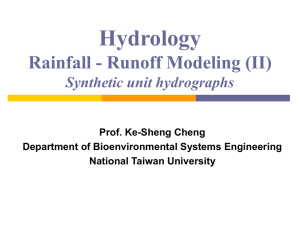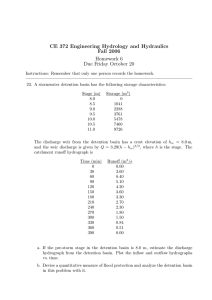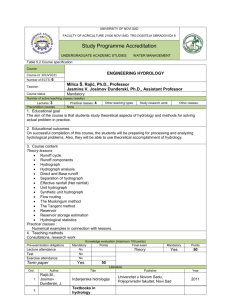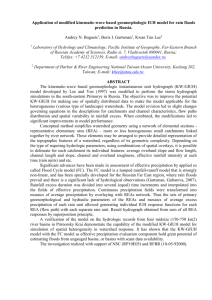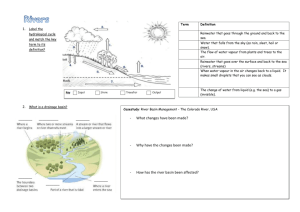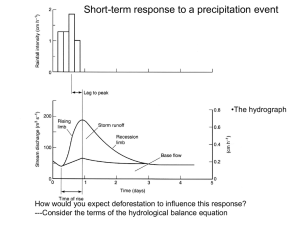IRJET-A Review of Synthetic Hydrograph Methods for Design Storm
advertisement
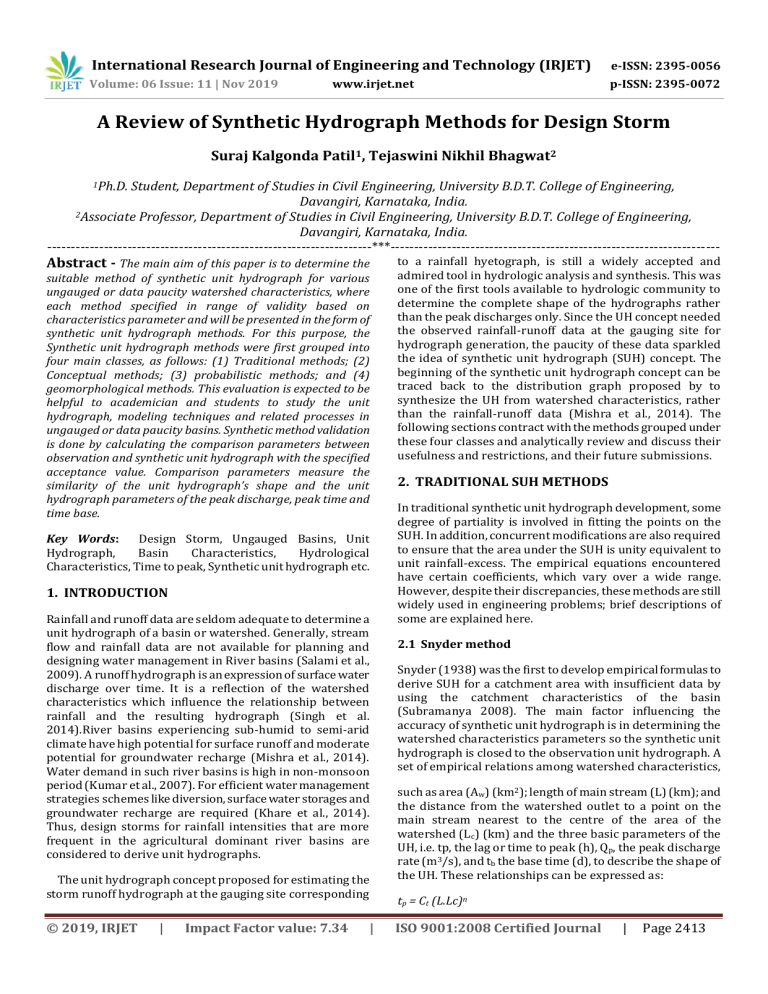
International Research Journal of Engineering and Technology (IRJET) e-ISSN: 2395-0056 Volume: 06 Issue: 11 | Nov 2019 p-ISSN: 2395-0072 www.irjet.net A Review of Synthetic Hydrograph Methods for Design Storm Suraj Kalgonda Patil1, Tejaswini Nikhil Bhagwat2 1Ph.D. Student, Department of Studies in Civil Engineering, University B.D.T. College of Engineering, Davangiri, Karnataka, India. 2Associate Professor, Department of Studies in Civil Engineering, University B.D.T. College of Engineering, Davangiri, Karnataka, India. ---------------------------------------------------------------------***---------------------------------------------------------------------- Abstract - The main aim of this paper is to determine the suitable method of synthetic unit hydrograph for various ungauged or data paucity watershed characteristics, where each method specified in range of validity based on characteristics parameter and will be presented in the form of synthetic unit hydrograph methods. For this purpose, the Synthetic unit hydrograph methods were first grouped into four main classes, as follows: (1) Traditional methods; (2) Conceptual methods; (3) probabilistic methods; and (4) geomorphological methods. This evaluation is expected to be helpful to academician and students to study the unit hydrograph, modeling techniques and related processes in ungauged or data paucity basins. Synthetic method validation is done by calculating the comparison parameters between observation and synthetic unit hydrograph with the specified acceptance value. Comparison parameters measure the similarity of the unit hydrograph’s shape and the unit hydrograph parameters of the peak discharge, peak time and time base. Key Words: Design Storm, Ungauged Basins, Unit Hydrograph, Basin Characteristics, Hydrological Characteristics, Time to peak, Synthetic unit hydrograph etc. 1. INTRODUCTION Rainfall and runoff data are seldom adequate to determine a unit hydrograph of a basin or watershed. Generally, stream flow and rainfall data are not available for planning and designing water management in River basins (Salami et al., 2009). A runoff hydrograph is an expression of surface water discharge over time. It is a reflection of the watershed characteristics which influence the relationship between rainfall and the resulting hydrograph (Singh et al. 2014).River basins experiencing sub-humid to semi-arid climate have high potential for surface runoff and moderate potential for groundwater recharge (Mishra et al., 2014). Water demand in such river basins is high in non-monsoon period (Kumar et al., 2007). For efficient water management strategies schemes like diversion, surface water storages and groundwater recharge are required (Khare et al., 2014). Thus, design storms for rainfall intensities that are more frequent in the agricultural dominant river basins are considered to derive unit hydrographs. The unit hydrograph concept proposed for estimating the storm runoff hydrograph at the gauging site corresponding © 2019, IRJET | Impact Factor value: 7.34 | to a rainfall hyetograph, is still a widely accepted and admired tool in hydrologic analysis and synthesis. This was one of the first tools available to hydrologic community to determine the complete shape of the hydrographs rather than the peak discharges only. Since the UH concept needed the observed rainfall-runoff data at the gauging site for hydrograph generation, the paucity of these data sparkled the idea of synthetic unit hydrograph (SUH) concept. The beginning of the synthetic unit hydrograph concept can be traced back to the distribution graph proposed by to synthesize the UH from watershed characteristics, rather than the rainfall-runoff data (Mishra et al., 2014). The following sections contract with the methods grouped under these four classes and analytically review and discuss their usefulness and restrictions, and their future submissions. 2. TRADITIONAL SUH METHODS In traditional synthetic unit hydrograph development, some degree of partiality is involved in fitting the points on the SUH. In addition, concurrent modifications are also required to ensure that the area under the SUH is unity equivalent to unit rainfall-excess. The empirical equations encountered have certain coefficients, which vary over a wide range. However, despite their discrepancies, these methods are still widely used in engineering problems; brief descriptions of some are explained here. 2.1 Snyder method Snyder (1938) was the first to develop empirical formulas to derive SUH for a catchment area with insufficient data by using the catchment characteristics of the basin (Subramanya 2008). The main factor influencing the accuracy of synthetic unit hydrograph is in determining the watershed characteristics parameters so the synthetic unit hydrograph is closed to the observation unit hydrograph. A set of empirical relations among watershed characteristics, such as area (Aw) (km2); length of main stream (L) (km); and the distance from the watershed outlet to a point on the main stream nearest to the centre of the area of the watershed (Lc) (km) and the three basic parameters of the UH, i.e. tp, the lag or time to peak (h), Qp, the peak discharge rate (m3/s), and tb the base time (d), to describe the shape of the UH. These relationships can be expressed as: tp = Ct (L.Lc)n ISO 9001:2008 Certified Journal | Page 2413 International Research Journal of Engineering and Technology (IRJET) e-ISSN: 2395-0056 Volume: 06 Issue: 11 | Nov 2019 p-ISSN: 2395-0072 www.irjet.net The area under the curve being equal to 1,196.5 square units, the peak discharge (Qp) is divided into 60 units (Hoffmeister & Weisman 1977) as in Eq; the base period (TB) is divided into 100 units as in Eq: Qp = 640 Cp A/tp TB = 5 [(tp/11) + tp] W50 = 2.14 (qp)–1.08 Qp = 60 Qu W75 = 1.22 (qp)–1.08 where tp (hours) is the time of lag to peak, Ct is a regional constant representing watershed slope and storage effects, L (kilometers) is the length of the main channel, L c (kilometers) is the length between the outlet and centroid of the watershed, the superscript “n” refers to the basin constant used in the calculation of the basin lag tp (in Snyder’s method, the value of n is taken as 0.3), Qp (cubic meters per second) is the peak discharge of a UH, Cp is an indication of the retention and storage capacity of the watershed, A (square kilometers) is the drainage area, TB (hours) is the base period, W50 and W75 (hours) are the widths at 50 and 75%, respectively, of peak discharge of an SUH, and qp (cubic meters per second per square kilometer) is the peak discharge per unit catchment area (Subramanya 2008). 2.2 Mitchells method By studying UHs for 58 Illinois watersheds ranging in area from 10 to 3,090 mi2, Mitchell (1948) established an SUH method based on the basin lag and the summation curve according to three classifications: area less than 175 mi 2, area of 175 to 750 mi2, and area over 750 mi2. Mitchell’s equation is given by (Thorvat and Patel 2016): t = 2.80 tp0.81 t = 1.05 A0.6 qs = And/0.03719 where t (hours) is the time lag between the centroid of effective rainfall hyetograph and the centroid of the DRH, A (square kilometers) is drainage area, qs (cubic meters) is the volume of surface runoff of 1 in. over the drainage area and nd is the number of intervals per day. 2.3 Commons method Commons (1942) established a dimensionless hydrograph from a study of major flood hydrographs in Texas. The parameters derived in this method are time unit (Tu) in hours, volume (V) of 1 cm of runoff in cubic meters, and unit discharge (Qu) in cubic meters per second as shown in Eq. Tu = Tp/14 V = 23, 23, 200A TB = 100 Tu 2.4 SCS method The SCS method (USDA 1957) utilizes the land use, soil type, and hydrological and antecedent moisture conditions of the catchment to estimate Qp and Tp; the SUH shape is then determined from an average dimensionless hydrograph, thus avoiding any manual fitting (Bhunya et al. 2009). The SCS dimensionless UH is assumed to be invariant (regardless of catchment shape, size, and location), although such an assumption may not be justified (Singh 2000). A relationship between Qp and Tp is given by Eq 14: Qp = 484 A Vq/Tp where A is drainage area of the basin (square kilometers) and Vq is the runoff volume (cubic meters) distributed uniformly over the drainage basin. 2.5 Taylor and Schwarz method The Taylor and Schwartz (TS) model was proposed by Taylor and Schwarz (1952) for SUH derivation using the data of 20 watersheds having drainage areas varying from 20 to 1600 mi2 (52–4144 km2). While deriving the SUH, the model specially considers the average slope of the main channel of the watershed and the other watershed characteristics, i.e. Aw, L and Lc similar to those in Snyder’s method. The average slope of the main channel is determined as: Where Sc is the average slope of the main channel, Si is the slope of the ith reach of the main channel and N is the total number of reaches. 3. CONCEPTUAL SUH METHODS This division deliberates the popular conceptual models of Clark (1945) and Nash (1957) along with some recently developed conceptual models used for SUH derivation. We also explore some of the conceptual models already available in the hydrological literature which have ample ability to be transmuted into SUH, and thus require the attention of the ungauged catchments research community for their analysis. Qu = V/(1,196.5 Tu 3600) © 2019, IRJET | Impact Factor value: 7.34 | ISO 9001:2008 Certified Journal | Page 2414 International Research Journal of Engineering and Technology (IRJET) e-ISSN: 2395-0056 Volume: 06 Issue: 11 | Nov 2019 p-ISSN: 2395-0072 www.irjet.net 3.1 Clark’s method Clark’s method for developing an SUH involves the application of an instantaneously applied unit (1 inch or 1 mm) of rainfall excess over a watershed and thereafter, the precipitation is mathematically conveyed to the watershed outlet through two components: a translation hydrograph and a linear reservoir (LR) routing. For derivation of an IUH, the Clark model uses two parameters: (a) time of concentration (TC) in hours, and (b) storage coefficient (K) in hours of a single LR, in addition to the time–area diagram. The governing equation of the Clark IUH model can be expressed as: Where Ui is the ith ordinate of the IUH and Ai the ith ordinate of the time–area diagram; C1 and C2 are Clark’s routing coefficients and can be computed by the following expressions: where q(t) is the depth of runoff per unit time per unit effective rainfall. It is noteworthy that parameter ‘n’ is dimensionless and ‘K’ has the unit of time. The area under the curve defined by above equation is unity. Thus, the rainfall-excess and direct surface runoff depths are equal to unity. The parameters ‘n’ and ‘K’ are often referred to as the shape and scale parameters of the Nash model, respectively, which can be computed using the method of moments or empirical equations available in the literature (Singh 2014, Bhunya et al. 2003). To obtain the SUH, the parameters of equation above are related to catchment characteristics. However, in spite of its wider applicability, the Nash model has been a topic of much discussion among the hydrological community for its inherent discrepancies. a conceptual flaw is that the instantaneous unit rainfall is input into only the farthest reservoir from the outlet of the watershed; this is equivalent to saying that for a given watershed, only the farthest area from the outlet receives any rainfall, and that this area receives the entire unit rainfall. 3.3 Dooge IUH method where Δt is the computational interval in hours. Finally, a UH of desired duration (D) is derived using the equation: where Ui is the ith ordinate of the UH of D-hour duration and computational interval Δt hours; and N is the number of computational intervals in D-hours, D/Δt. Although not stated as a purpose, Clark’s model was the first fully timedistributed SUH technique. However, for ungauged basins, TC and K are difficult to estimate. 3.2 Nash IUH method Nash (1957) developed a conceptual model based on a cascade of ‘n’ equal LRs with equal storage coefficient ‘K’ for derivation of the IUH for a natural watershed. Notably, in the model formulation, an instantaneous unit depth of effective rainfall is allowed into only the farthest (nth) reservoir in a series (in the Nash model the reservoir closest to the outlet is the first reservoir and the farthest in the series is the nth reservoir) and is then routed through the remaining reservoirs. The outflow of each reservoir serves as the inflow into the next reservoir in the series as the flow moves towards the outlet of the watershed. The outflow of the first reservoir of the series, at the outlet of the watershed, is considered to be the IUH for the watershed. The analytical form of the model can be expressed as: © 2019, IRJET | Impact Factor value: 7.34 | Dooge (1959) used the concept of a LC and represented the basin (system) by a series of LCs and LRs. The outflow from the LC was represented by a time–area diagram which, together with outflow from the preceding sub-area, serves as the inflow to the LR. The expression developed for the IUH can be expressed as: where S is the input volume taken as unity; T is the total transmission time of the basin (=LC with L as the total channel length of the basin and C the translation coefficient for all LCs); i is the order of reservoirs equal to 1, 2, 3 … counted downstream to the basin outlet; i(τ) is the function of τ representing an integer equal to the order number of the sub-area; Ki is the storage coefficient of the ith reservoir; D is the differential operator (d/dt); δ(t – τ) is the Dirac-delta function, where t is the elapsed time, τ is the translation time between the elements in the sub-area and the outlet; and ω(τ/T) is the ordinate of a dimensionless time–area diagram. 4. PROBABILISTIC METHODS An application of probability distribution functions as SUH has a long successful hydrological history. Due to similarity in the shape of statistical distributions and a conventional UH, several attempts have been made in the past to use their probability density functions (pdfs) for derivation of the SUH. In practice, two approaches are followed for deriving a UH from recorded flood hydrographs and simultaneous rainfall records. The first is a non-parametric approach ISO 9001:2008 Certified Journal | Page 2415 International Research Journal of Engineering and Technology (IRJET) e-ISSN: 2395-0056 Volume: 06 Issue: 11 | Nov 2019 p-ISSN: 2395-0072 www.irjet.net based on a discretization technique, i.e. determination of a model at a finite number of discrete points. This includes the least-squares method, matrix inversion, linear programming, nonlinear programming and the transfer function method. The second one is a parametric approach that fits some prescriptive functional curves with a limited number of parameters, and these parameters are estimated by means of optimization using an objective function or through any suitable approach. For instance, Nash derived an IUH based on the concept of ‘n’ LRs of equal storage coefficient and showed that the IUH shape can be represented by a twoparameter gamma distribution (2PGD). He derived the parameters of the 2GPD by the method of moments using observed hyetographs and hydrographs. The nonparametric methods are believed to be more accurate because they use a larger number of points for UH derivation. Therefore, they are widely used for UH derivation despite the disadvantage that there are a large number of correlated parameters in the UH model, which makes the estimation problem ill-formed and sometimes yields negative UH ordinates. Further, the large number of parameters involved in the derivation of the UH using these methods can lead to the problems of computational instability, which restricts the practical application of these techniques. 5. GEOMORPHOLOGIC METHODS Presently hydrologists have found it more convenient to couple the distribution function-based approach with the classical GIUH approach for development of SUH models by harvesting the geographic information systems (GISs) and remote sensing (RS) technologies. This section deals with the GIUH approach right from its origin to the most recent developments and applications in hydrological sciences. The geomorphological methods, pairing the principles of hydrological systems with quantitative geomorphology, were proposed to represent the IUH of a given basin, and are popularly known as geomorphological instantaneous unit hydrograph (GIUH) models. In this regard, several attempts were made in the past to establish relationships between the parameters of the models for ungauged catchments, and the physically measurable watershed characteristics. Thus, linking quantitative geomorphology with basin hydrological characteristics can provide a simple way to understand the hydrological behavior of different basins, particularly ungauged ones. These characteristics relate to the physical characteristics of the drainage basin as well as the drainage network. The physical characteristics of the drainage basin include drainage area, basin shape, ground slope and centroid. Whereas in a drainage network, the important channel characteristics include the number of channels of different orders, their lengths and slopes. With the recent development of GIS tools, it is now possible to determine hydrological and watershed geomorphological parameters using DEMs/digital terrain models (DTM). computer-based methodology known as GIS was a predictable step in the evolution of hydrological sciences. A GIS links land cover data to topographic data and to other information concerning processes and properties related to geographic location. When applied to hydrologic systems, non-topographic information can include description of soils, land use, ground cover, groundwater conditions, as well as man-made systems and their characteristics on or below the land surface. The application of GIS in natural resources and engineering can be traced back to 1980–1990, and since then, continued efforts have been put into research and development and exponential growth has occurred in GIS applications in natural resources, particularly land and water resources. The ArcGIS and Qgis software packages are commonly used to process DEMs to extract the hydrological parameters or physical characteristics of a catchment and can serve for GIUH model-based simulations. As discussed above, one of the most important tasks of theoretical, as well as practical hydrology is to find the laws of runoff processes in river basins. The difficulty of this task increases when there is a lack of hydrological data. Where no hydrological data are available at all, one of the possibilities is the determination of the runoff hydrograph by means of a relationship between characteristics of the quantitative geomorphology of drainage basins and channel networks and the parameters of an IUH. In the last few years, the usual cartographic representation of basin morphological parameters has been gradually substituted by digital representations in the form of DEM. The ease with which such information can be processed has stimulated the development of automatic procedures that alleviate the burden of some typical hydrological pre elaborations (e.g. drainage basin and sub-basin delineation, drainage path calculation, drainage network extraction, basin and stream ordering, geomorphological/morphometric parameters. Based on these notable works, it can be concluded that the recent exponential developments in RS technologies and GIS facilities can be effectively utilized to address the lack of hydrological data in data paucity basins. Consequently, the hydrological models for data scarce basins should be able to use these new kinds of methods. 6. APPROACHES WITH DIFFERENT METHODS Since so much of hydrology is linked to processes at the Earth’s surface, the connection with the topographic, The basins where is data is insufficient or absent creates major problem in hydrological research and SUH methods are widely used for developing unit hydrographs for such basins. In this study, the SUH methods/approaches available in the literature, improved soft computing techniques/ algorithms, were thoroughly reviewed and summarized for their capabilities and limitations. The models were classified into four groups: Traditional (or Empirical), Conceptual, Probabilistic and Geomorphological methods. The pros and cons of four classes of methods were summarized with regard to their wider applications. Though the traditional methods of Snyder and SCS are widely used for SUH derivation, they have several inconsistencies. The conceptual models of Nash and Clark define the standard shape of the © 2019, IRJET ISO 9001:2008 Certified Journal | Impact Factor value: 7.34 | | Page 2416 International Research Journal of Engineering and Technology (IRJET) e-ISSN: 2395-0056 Volume: 06 Issue: 11 | Nov 2019 p-ISSN: 2395-0072 www.irjet.net UH using the minimum number of parameters and have witnessed numerous applications in hydrological studies, including for the areas they were not originally intended to solve. However, models such as Dooge IUH require further exploration, given their enhanced efficacy and applicability. With the development of GIUH methods it was possible to compute salient parameters of an ungauged basin and to get the complete SUH shape. These models have had many applications in ungauged basins hydrology. The developments in RS technologies to avail high resolution DEMs and simultaneous advances in DEM processing software and algorithms for extracting geomorphological information has improved the practical applicability of these models manifold. Notably, these advances have facilitated extraction of typical hydrological information. For deriving the complete shape of UH for ungauged catchments can be considered as a major part of hydrology in order to satisfy the constraint of unit volume and depth. 7. CONCLUSION In this review study, the SUH models widely used for flood hydrograph modeling from ungauged basins were critically reviewed and thoroughly summarized for their uses and limitations. The reviewed SUH models were classified into four groups as: (1) Traditional or empirical, (2) Conceptual, (3) Probabilistic and (4) Geomorphological. The applicability of each class of models in ungauged or data scarce basin hydrology is considered. It is found that the traditional SUH models have several inconsistencies associated with them; however, these models are widely used for SUH derivation. The strong mathematical and conceptual basis of probabilistic SUH models and the models based on geomorphological perception of a drainage basin, successfully fill the technological gap for unit hydrograph estimation from ungauged or data paucity catchments. Therefore, the geomorphological class of the SUH models can be thought of as the most useful and appealing approach for while predicting runoff in ungauged or data paucity catchments REFERENCES [1] Adejamo L.A & Adinaran K.A., (2016), “Estimation of Design Flood Hydrographs for Osun River at Iwo Control Station in Osun State, Nigeria”, FUOYE Journal of Engineering and Technology, Volume 1, Issue 1, pp. 43-47. [2] Adib A., Salarijaz M. & Najafpour K., (2010), “Evaluation of Synthetic Outlet Runoff Assessment Models”, J. Applied Science & Environment Management, Vol. 14 No. 03, pp. 13-18. [3] Bhunya P.K., Panda S.N. & Goel M.K., (2011), “Synthetic Unit Hydrograph Methods: A Critical Review”, Open Hydrology Journal, Vol.5, pp. 1-8. © 2019, IRJET | Impact Factor value: 7.34 | [4] Hoffmeister G. & Weisman R.N., (1977), “Accuracy of synthetic hydrographs derived from representative basins”, Hydrological Sciences Bulletin, pp. 222-297. [5] Kumar R., Chatterjee C., Lohani A., Kumar S. & Singh R., (2007), “Flood estimation for an ungauged catchment using Geomorphological Instantaneous Unit Hydrograph (GIUH) models”, Hydrological Processes, pp.13-17 [6] Limanrea L.M., (2009), “The Limiting Physical Parameters of Synthetic Unit Hydrograph”, World Applied Sciences Journal, Vol. 7, No. 06, pp. 802-804. [7] Majidi A & Moradi M., (2012), “Evaluation of Synthetic Unit Hydrograph (SCS) and Rational Methods in Peak Flow Estimation”, International Journal of Hydraulic Engineering, Vol.1 No.5, pp.4347. [8] Mishra N., Khare D., Gupta K.K. & Shukla R., (2014), “Impact of Land Use Change on Groundwater ‐ A Review”, Advances in Water Resource and Protection (AWRP) Vol. 2, Issue 2, pp. 28-41. [9] Mustafa S. & Yusuf M.I., (2012), A Textbook of Hydrology and Water Resources, Revised Edition, Topsmerit Page Publishing Co., Abuja, Nigeria. [10] Ogunlela A.O., Adewale P.O. & Adamowski J.F., (2012), “Developing design storm hydrographs for small tropical catchments with limited data”, Ethiopian Journal of Environmental Studies and Management, Vol. 5, No. 4, pp. 356-365. [11] Ramirez J.A. (2000), “Prediction and Modeling of Flood Hydrology and Hydraulics”. Chapter 11 of Inland Flood Hazards: Human, Riparian and Aquatic Communities. Edited by Ellen Wohl, Cambridge University Press. [12] Safarina B.A., Salim T.H. & Hadihardaja I.K., (2011), “Clusterization of Synthetic Unit Hydrograph Methods Based on Watershed Characteristics”, Vol.11, No.06, pp. 76-85. [13] Salami A.W., Bilewu S.O. & Ayansola A.M., (2009), “Evaluation of synthetic unit hydrograph methods for the development of design storm hydrographs for Rivers in South-West Nigeria”, Journal of American Science, Vol. 5 No.(4), pp.23-32. [14] Singh P.K., Mishra S.K. & Jain M.K., (2014), “A review of the synthetic unit hydrograph: from the empirical UH to advanced geomorphological methods”, Hydrological Sciences Journal, Vol. 59, No.2, pp.239-261. ISO 9001:2008 Certified Journal | Page 2417 International Research Journal of Engineering and Technology (IRJET) e-ISSN: 2395-0056 Volume: 06 Issue: 11 | Nov 2019 p-ISSN: 2395-0072 www.irjet.net [15] Subramanya K., (2008), “Engineering Hydrology” 3rd edition, Tata McGraw Hill Publishing Company, New Delhi. [16] Sule B.F. & Alabe S.A., (2013), “Application of synthetic unit hydrograph methods to construct storm hydrographs”, International Journal of Water Resources and Environmental Engineering, pp.540549. [17] Thorvat A.R. & Patel J.N., (2016), “Synthetic Unit Hydrograph Development for Ungauged Basins Using Dimensional Analysis”, Journal of American Water Works Association Vol. 108, No.03, pp. 145153. [18] Zhao B., Tung Y.K., Yeh K.C. & Yang J.C., (1995), “Statistical validation methods: application to unit hydrographs”, Journal of Hydrology Engineering, Vol.121, No.8, pp.121-618. BIOGRAPHIES Prof. Suraj Kalgonda Patil working as an Assistant Professor in Department of Civil Engineering Dr.J. J. Magdum College of Engineering, Jaysingpur Dist. Kolhapur, Maharashtra, India. Presently pursuing Ph.D. in Department of Studies in Civil Engineering, University B.D.T. College of Engineering, Davangiri, Karnataka, India. Dr. Mrs. Tejaswini N. Bhagwat working as an Associate Professor in Department of Studies in Civil Engineering, University BDT College of Engineering, Davangere, Karnataka, India. © 2019, IRJET | Impact Factor value: 7.34 | ISO 9001:2008 Certified Journal | Page 2418
